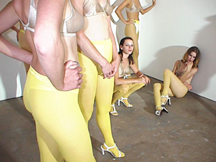 Vanessa
Beecroft (b. 1969, Genoa,
Italy)
Vanessa
Beecroft (b. 1969, Genoa,
Italy)maria elena
buszek :
From
Contemporary
Artists.
5 ed. Detroit: St. James Press, 2001
 Vanessa
Beecroft (b. 1969, Genoa,
Italy)
Vanessa
Beecroft (b. 1969, Genoa,
Italy)
Few contemporary artists divide critics like performance artist—or, more correctly, performance director—Vanessa Beecroft. Descriptions of her tableaux vivants of hired, creatively blocked models, often wearing little more than designer underwear, range from “symbolically layered” to “fantastically shallow.” But few critics or audiences would deny that her human installations conjure uncomfortable emotions that force one to confront the interrelation of art, commercialism, and voyeurism, regardless of whether they feel the artist’s work critiques or is complicit in this relationship.
Beecroft’s studies of architecture and stage design are apparent in her performance pieces, where a group of models is precisely arranged in a gallery environment like so many set pieces. Their decorative nature is underscored through Beecroft’s demand that they avoid movement, expression, and eye contact with the audience or one another. Since 1994 these installations were comprised of all-female ensembles that, through the use of costumes, wigs, and body paint, became increasingly uniform. Considering her view of these women as her “army,” it seems logical that Beecroft would eventually look literally to the military as an ideal of such uniformity, and has since arranged several exhibitions of Navy personnel in the same manner as her better-known arrangements of female fashion and art models. Although the meanings of these different “casts” inevitably evoke wildly different interpretations, in all cases the setting was the same: the models, unresponsive and passively still, would hold positions dictated by the artist—allowing for an occasional rest, if they remain in place—for a period of two to four hours, during which time the audience mills about the living sculpture.
Since the earliest of Beecroft’s performances, such as VB08 at New York’s P.S. 1 Contemporary Art Center, she has demonstrated a twin interest in three-dimensional composition and audience-performer dynamics that betray her theatre background. In this particular work a group of ten attractive young women—wearing sensible underwear and cartoonish, red yarn wigs braided Pippi Longstocking-style—took over a corner of P.S. 1 and lounged with a disinterest in their surroundings that seemed to parody the cool affectations of the New York art audience taking in the performance itself. By the presentation of VB16 at Deitch Projects just two years later, Beecroft had completely shrugged off the openly comical undertone of the earlier work. Here, her models far more closely resembled—in both costume and physique—the “supermodels” of popular fashion magazines. In this work, however, the glamorous veneer of the slim, platinum-bobbed women was designed to fade. The longer the audience stared, the more likely they were to confront the models’ and their own vulnerabilities: the models’ bodies distorted through the control-top pantyhose worn over their underpants; the longer the women stood in their strappy high heels the less perfect their pose and swollen their ankles; and the mere fact of the audience’s necessary meditation on this human installation forced them to confront their own inappropriate notice and judgment of these imperfections.
It is just this time-based aspect of Beecroft’s installations that is often forgotten in the sensationalistic imagery through which most are introduced to her work. Naturally, the documentation of her performances reminds us of the disturbing nature of her “objects.” In photographs the often rail-thin physiques of certain exhibition’s models, and her increased association with prominent fashion houses like Prada and Gucci—her 1998 VB 35: SHOW exhibition at the Solomon R. Guggenheim museum in New York being the best known example—immediately remind the viewer of similar, ubiquitous imagery with which one is assaulted through fashion journalism and advertising. Of course, her very choice to use these body types and brand names only add credence to interpretations of her work that lament its shallowness and commercialism. The performances themselves, however, are an exercise in the power of that which arguably defines postmodernity—theatricality. In the tradition of Fluxus, the performance/installation itself almost becomes secondary to the process unfolding and the audience reacting—under the blazing theatrical lights the charge of the mere potential for a taboo breaking rupture between audience and artwork is palpable, even though the audiences are almost uncontrollably compelled to keep their distance. Perhaps the most telling aspect of a Beecroft performance is the inevitable projection of identity upon the anonymous, seemingly homogeneous models; the longer each audience member lingers over the work, the more one overhears the increasingly comfortable audience speculating on their identities, as if they were so many ambiguously attributed, classical caryatids.
In much the same way that audience projection plays a crucial part in Beecroft’s work, so does the artist’s own, similar approach to her conception of the performances. In fact, her tendency to project her own identity and neuroses upon her doll-like models was perhaps clearest in her first solo exhibition in 1993, based on a journal the artist had kept for eight years. The journal, which obsessively chronicled the artist’s eating habits, battle with anorexia, and revelations through psychiatric counseling, was displayed alongside drawings inspired by its contents, and only viewed by a small, all-female audience that she had hand-picked based on each woman’s resemblance to the artist herself. Once the audience arrived, the relevance of their resemblance became clear as the artist went immediately about “correcting” her guests’ appearance or composure, arranging them around the gallery into something of an ideal, multiple self-portrait. In an almost shamanistic act of catharsis and self-healing, the artist effectively transfers her own issues with self-control and rigid order from her body to another’s. Whereas many of critics address the impersonal nature of her homogenous, passive subjects, others recognize this very human tendency in her performances, whereby the models become both her medium and her surrogates. The disconcerting nature of her work is in Beecroft’s invitation to her audiences to similarly indulge in this neurotic, voyeuristic scenario in the safe and amoral theatrical space she has constructed.